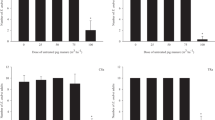Abstract
Two beef cattle feedlot experiments were conducted to determine the amount of certain agricultural chemicals that are likely to be found in both fresh and stored feedlot manure and to investigate fly control in this manure. In experiment 1, diethylstilbestrol (DES), chlortetracycline (CTC), and ronnel were used as feed additives. Fresh manure, stored manure, runoff water, manure weathered on pasture, and soil from pasture fertilized with manure were analyzed for these additives. Stirofos was added to fresh manure as a larvicide for fly control. In experiment 2, the residue aspects of DES and CTC were repeated. In this experiment, stirofos instead of ronnel was fed with DES and CTC. Sixty-eight percent of the DES fed to cattle appeared in fresh manure and 52% in manure stored for 12 weeks. Comparable percentage values were 17 and 11% for CTC and 13 and 3% for ronnel; somewhat less DES and CTC were found when a concentrate diet was fed. Detectable amounts of DES, CTC, and ronnel were not found in runoff water, weathered manure, or soil. Adding an emulsifiable concentrate formulation of stirofos directly to manure at a rate of approximately 45 ppm of wet manure completely controlled the larvae of house fly (Musca domestica L.) whereas feeding stirofos at a rate of 1.5 mg per kg of body weight daily reduced larval counts 82% in manure from forage-fed heifers and 63% in manure from concentrate-fed heifers. Stirofos was not detected in runoff water, weathered waste, or soil
Access this article
We’re sorry, something doesn't seem to be working properly.
Please try refreshing the page. If that doesn't work, please contact support so we can address the problem.
Similar content being viewed by others
References
Aschbacher, P. W., and V. J. Feil: Degradation of diethylstilbestrol in feces. J. Anim. Sci.41, 263 (1975).
Aschbacher, P. W., and E. J. Thacker: Metabolic fate of oral diethylstilbestrol in steers. J. Anim. Sci.39, 1185 (1974).
Bonino, Cesare: Degradation of Stilbestrol by soil microorganisms. Atti. Acad. Nazl. Lincei Rend., Classe Sci. Fis., Mat. Nat.32, 80 (1962).
Broom, W. A., M. R. Gurd, G. L. M. Harmerand, and S. S. Randall: The stability of Hexoestrol in soil and its uptake by plants. J. Endocrinol.21, 381 (1961).
Bowman, M. C., Morton Beroza, C. H. Gordon, R. W. Miller, and N. O. Morgan: A method for analyzing the milk of cows for coumaphos and its oxygen analog after feeding coumaphos for control of house fly larvae. J. Econ. Entomol.61, 358 (1968).
Dinius, D. A., R. R. Oltjen, and T. S. Rumsey: Pelleted forage diets plus energy and feed additives for finishing beef cattle. J. Anim. Sci.41, 868 (1975).
Donoho, A. L., W. S. Johnson, R. F. Seick, and W. L. Sullivan: Gas chromatographic determination of diethylstilbestrol and its glucuronide in cattle tissues. J. Ass. Offic. Anal. Chem.56, 785 (1973).
Doyle, T., N. Filipescue, W. R. Benson, and D. Baines: Photocyclization ofa,a′ diethyl 4,4′ stilbenediol: Isolation of a stable tautomer of the elusive dihydrophenanthrenes. J. Amer. Chem. Soc.92, 6371 (1970).
Glascock, R. F., and H. E. H. Jones: The uptake of Hexoestrol by plants and its persistance in soil. J. Endocrinol.21, 373 (1961).
Gregers-Hansen, Birte: Decomposition of diethylstilbestrol in soil. Plant and Soil20, 50 (1964).
Hacker, R. G., D. D. Cruea, W. Shinoda, and M. L. Hopwood: Uptake of diethylstilbestrol by edible plants. J. Anim. Sci.26, 1358 (1967).
Hinds, F. C., H. H. Drapes, G. E. Mitchell, Jr., and A. L. Neumann: Metabolism of labeled diethylstilbestrol in ruminants. J. Agr. Food Chem.13, 256 (1965).
Huber, T. L., G. W. Horn, and R. E. Beadle: Liver and gastrointestinal metabolism of diethylstilbestrol in sheep. J. Anim. Sci.34, 786 (1972).
Jurtshuk, P., Jr., R. N. Doetsch, J. J. McNeill, and J. C. Shaw:In vitro studies of the effect of Aureomycin and Terramycin on mixed suspensions of bovine rumen bacteria. J. Dairy Sci.37, 1466 (1954).
Martin, M., and D. Gottlieb: The production and role of antibiotics in soil. IV. Activity of five antibiotics in the presence of soil. Phytopathology45, 407 (1955).
Miller, R. W.: Larvicides for fly control—a review. Bull. Entomol. Soc. Amer.16, 154 (1970).
Miller, R. W., and C. H. Gordon: Technical rabon for larval housefly control in cow manure. J. Econ. Entomol.65, 1064 (1972).
Miller, R. W., and L. G. Pickens: Feeding of Coumaphos, Ronnel and Rabon to dairy cows: Larvicidal activity against house flies and effect on insect fauna and biodegradation of fecal pats: J. Econ. Entomol.66, 1077 (1973).
Plapp, F. W., and J. E. Casida: Bovine metabolism of organophosphorus insecticides. Metabolic fate of0,0-dimethyl0-(2,4,5-trichlorophenyl) phosphorothioate in rats and a cow. J. Agr. Food Chem.6, 662 (1958).
Rao, S. L. N., and W. P. McKinley: Metabolism of organophosphorus insecticides by liver homogenates from different species. Can. J. Biochem.47, 1155 (1969).
Samuel, B. L.: An improved screening method for chlorinated and thiophosphate organic insecticides in foods and feeds. J. Ass. Off. Anal. Chem.49, 346 (1966).
Van Soest, P. J.: Use of detergents in the analysis of fibrous feeds. II. A rapid method for the determination of fiber and lignin. J. Ass. Off. Anal. Chem.46, 829 (1963).
Author information
Authors and Affiliations
Rights and permissions
About this article
Cite this article
Rumsey, T.S., Miller, R.W. & Dinius, D.A. Residue content of beef feedlot manure after feeding diethylstilbestrol, chlortetracycline and ronnel and the use of stirofos to reduce population of fly larvae in feedlot manure. Arch. Environ. Contam. Toxicol. 6, 203–212 (1977). https://doi.org/10.1007/BF02097761
Received:
Accepted:
Issue Date:
DOI: https://doi.org/10.1007/BF02097761




